Most people consume digital content by scrolling quickly through feeds. According to Facebook, the average user spends 1.7 seconds on a piece of content in their mobile feed before deciding to move on. For advertisers, this means the first impression is everything. Knowing the psychological cues that stop a scroll can make the difference between being ignored and driving clicks.
1. Visual Contrast and Bright Colors
Humans are wired to notice contrast. Ads with bold colors, high contrast, or unusual patterns disrupt the uniform look of social feeds, grabbing attention. Studies show that ads using vibrant visuals can increase engagement by up to 40% compared to muted designs.
2. Faces and Emotional Cues
People are drawn to faces. Neuroscience research reveals that humans process faces in just 100 milliseconds. Ads showing facial expressions—joy, surprise, or curiosity—create an emotional connection that makes people pause.
3. Movement and Motion
Dynamic elements, such as short videos, GIFs, or animations, naturally attract the human eye. Motion signals relevance and novelty, making users more likely to stop scrolling. In fact, video ads on social platforms generate 3x more engagement than static images.
4. Curiosity and Storytelling
When an ad sparks curiosity, people are compelled to stop and learn more. Headlines or visuals that hint at a story—without revealing everything—trigger the brain’s need for closure, encouraging clicks.
5. Social Proof Signals
Seeing what others like or recommend influences behavior. Ads featuring reviews, testimonials, or popularity cues (like “500+ bought today”) leverage social proof to slow the scroll and build trust instantly.
6. Personal Relevance
Users stop when an ad feels tailored to them. Facebook reports that personalized ads drive 91% higher engagement. Using audience targeting and customized creatives ensures the ad resonates with the right viewers.
7. Novelty and Surprise
Unexpected elements—whether unusual visuals, unique product use cases, or humor—break scrolling patterns. Novelty activates the brain’s reward system, making the ad stand out in a crowded feed.
8. Minimalist Design
Paradoxically, simplicity can also stand out. While busy feeds are full of flashy designs, a clean, minimalist ad can create contrast by giving the eye a “resting point,” drawing users in.
Final Thoughts
The psychology of scroll behavior highlights the importance of first impressions in digital advertising. By tapping into visual contrast, emotional cues, movement, and relevance, advertisers can design ads that capture attention and stop the scroll.

